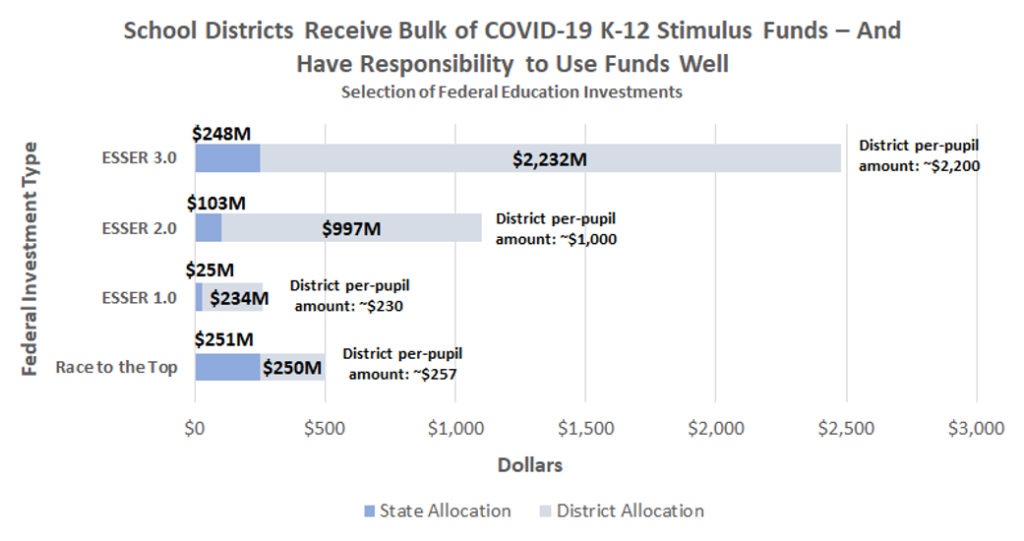
Tennessee is set to receive approximately $20-30 billion in federal funding through the American Rescue Plan, with more than $3.3 billion dedicated to K-12 and higher education. Given the significant student needs during the pandemic and through the recovery, Tennessee has the opportunity to address those needs and also invest in a strong, durable recovery for student instructional time and learning.
This support is especially needed for students from economically disadvantaged backgrounds, students facing digital divide challenges, and Black and Hispanic students (who disproportionately lacked in-person learning options during the pandemic or did not choose them out of safety concerns. A significant and growing body of research also shows the relationship between school spending and outcomes — even more so for economically disadvantaged students. Investing wisely can make an outsized impact for students.
Federal guidance and details are forthcoming on how other federal funds for broadband, students with disabilities, homeless students, and other needs will be distributed. The bulk of the funds to support education are found in the American Rescue Plan’s new contributions to the Education Stabilization Fund (ESF). The ESF has multiple components to support COVID-19 recovery in education and includes:
| Education Stabilization Fund Components | American Rescue Plan Total | TN Total |
| Elementary and Secondary School Emergency Relief Fund (ESSER) | $122.8 billion | $2.48 billion |
| Higher Education Emergency Relief Fund (HEERF) | $39.6 billion | $703 million |
| Emergency Assistance to Non-Public Schools (EANS) program | $2.75 billion | $80 million |
Compared to previous federal stimulus funds for education in ESSER 1.0 and ESSER 2.0, this latest round of funding represents the single largest injection of federal dollars into Tennessee’s K-12 education system. Additionally, Tennessee will receive $6.3 billion in general state ($4 billion) and local ($2.3 billion) government aid that could be flexibly spent on a variety of purposes, including education.
Elementary and Secondary School Emergency Relief Fund (ESSER) 3.0
Tennessee will receive $2.48 billion of the nationally available $122.8 billion in ESSER 3.0 funds, which the state must allocate according to federal guidelines:
- At least 90 percent (~$2.2 billion) must be awarded as subgrants to local education agencies (LEAs) with allocations based solely on the Title I formula.
- At least 5 percent (~$124.3 million) must be used to address learning loss through evidence-based interventions (e.g., summer learning, extended day, and extended school year programs).
- At least 1 percent (~$24.8 million) must be included for summer enrichment activities.
- At least 1 percent (~$24.8 million) must be dedicated to after-school programs.
For ESSER 3.0 funds, each LEA must use at least 20 percent of allocated funds to address learning loss, with the rest intended to help make schools safe for in-person instruction (e.g., repairing ventilation systems, reducing class sizes, and purchasing personal protective equipment). This is similar to ESSER 2.0 funds, but the percentages are new. ESSER 3.0 will be available at least through September 2024. Additional federal guidance will be available around June.

ESSER 3.0 funds also require a state maintenance of effort as well as state and local maintenances of equity — a new policy designed to protect high-need and high-poverty districts from budget cuts. Details are forthcoming on how these policies will be operationalized.
Higher Education Emergency Relief Fund (HEERF) 3.0
The American Rescue Plan provides $39.6 billion to US postsecondary institutions, with 91 percent ($20.6 billion) of funds allocated to public and private institutions directly. Tennessee institutions will receive an estimated $702.6 million. Institutions are required to spend at least the same amount on emergency financial assistance grants as required under the CARES Act. Other uses include monitoring and mitigating COVID-19, as well as outreach to financial aid applicants regarding eligibility for aid based on employment or income status of families or students themselves.
Institutions are allocated funds based on the weighted proportion of certain student populations:
- 37.5 percent for full-time-equivalent Pell recipients not exclusively in online instruction
- 37.5 percent for actual headcount number of Pell recipients not exclusively in online instruction
- 11.5 percent for full-time-equivalent non-Pell students not exclusively in online instruction
- 11.5 percent for actual headcount number of non-Pell students not exclusively in online instruction
- 1 percent for Pell in distance education only
- 1 percent for Pell in mixed distance education and traditional instruction
Nine percent of HEERF funds are provided to institutions participating in special programs, providing occupational training, or demonstrating significant unmet COVID recovery needs.
In the coming weeks, our team will share additional resources on how districts and the state can make the most of these funds to drive an equitable recovery and emerge with a more student-focused education system.
Peter Tang is SCORE’s director of research. Kevin Brown is a graduate fellow at SCORE.
(This post was updated on May 26 with new material to correct the description of HEERF funding weights.)
Read more:
